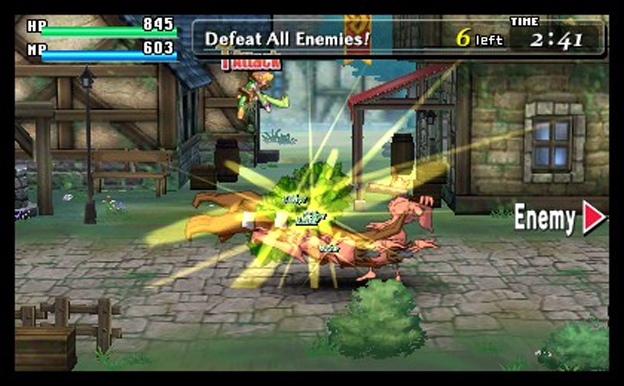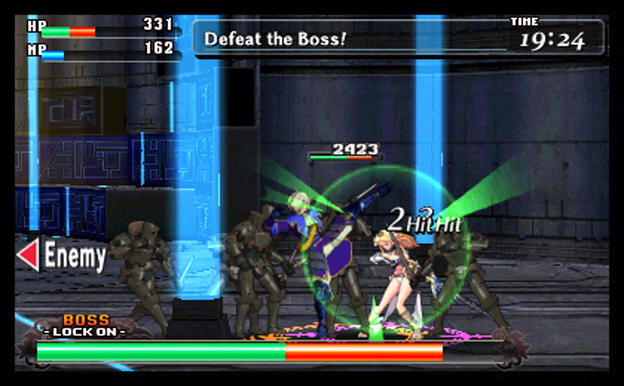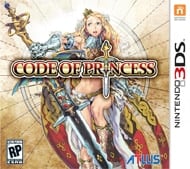Well Excuse Me, Princess
I sat in the dojang, 3DS in hand, volume muted so as not to bother the class in the room beyond. The click of its D-Pad, of the buttons on its face, however, were drowned out by the voices of those around me, the parents, as well as the yells of their children from within the classroom. Five minutes later, however, I flipped the handheld shut, walked out the door, and perused the shelves of the CVS across the street instead, killing time until my own class began. Perhaps this needs a bit more spelling out, because Code of Princess deserves it. The game is, after all, a cautionary tale, and one that hits me particularly hard because I was so strongly invested in it.
When I saw the game at E3, I was surprised by how similar it was to a SEGA Saturn classic, Guardian Heroes, with its 2D, side-scrolling beat ‘em up action set in levels with multiple foreground and background tracks. Its action combat, its RPG-esque leveling and stat distribution, all of them seemed culled directly from an absolute favorite of mine, one of the greatest concepts in all of gaming. Guardian Heroes, after all, meshed beat ‘em ups and RPGs with fighting games and anime-esque graphics.

Code of Princess is two-for-four on that, and it’s missing the ones that really count.
This is, however, a gorgeous game. Most of the time. The characters are lively and incredibly smoothly animated, oozing visual depth as they seem to flow through their animations in such a manner that, at times, it’s difficult to tell whether they’re sprites or polygon-based models. The enemies and player characters alike have this stupendous attention to detail and the same rich fluency about their motion, though the backgrounds tend to suffer for it, generic and under-detailed, with blurry and flat textures.
Most galling, though, is the slowdown, which is an element that makes the 3DS’ eponymous effect entirely worthless. Often, if one is to turn the 3D effect on, the game experiences crippling slowdown, which persists until the slider is brought all the way down to nil. It’s not a minor visual issue, either. It’s so slow that the game misses inputs and induces a sizable lag-time for those it does read. Even with the 3D effect off, the game’s frame rate can slip into the teens during larger battles, when the camera is zoomed out to the extreme. If one is to turn the 3D on during such a sequence, expect a single-digit frame rate. It’s a pretty sizable loss, too, since the 3D effect is great for telling which track any given enemy is on, even when they’re all clustered together around you. I hate losing that strategic edge, but it’s necessary in the name of playability.

So, the frame rate sucks. That’s forgivable, though, if there are rich RPG elements to be had, right? And, to a point, there are. Code of Princess gives experience to whichever character you used to complete a given level, often generously, which graces you with stat points to distribute at will. Further, characters can equip a plethora of equipment and accessories, the lot of which contribute to their stats, often having penalties in one to balance a benefit in another. Equipment is either gained upon level completion or purchased from a shop that opens up early on in the game, using money earned by beating levels. The shop’s inventory changes rapidly, and seemingly randomly, which makes it possible to gain a wide variety of equipment for the game’s multitude of playable characters.
That said, grinding levels can get dull, since one’s only real options for doing it are to either replay levels one has already finished (whether in regular story mode or in “free play”), or bull through the “bonus” quests, which are all just excuses for extended monster battles without any sort of context. Of note, the aforementioned “free play” consists only of the levels from the story campaign, but since the primary story mode is only playable by four of the game’s dozens of characters, the rest must be leveled through free play.

Which brings us to the element that doesn’t serve Code of Princess especially well: its gameplay. While Code of Princess has the frameworks of Guardian Heroes, its combat is depressingly one-note, providing the player with a block, dodge, light attack, heavy attack, “marking” attack, “burst” technique, and a few special moves unique to each character. Given how lame enemy A.I. is and how limited each character’s move set actually is, combat will invariably fall into the following rhythm: “Lock-on” to target to double damage. Engage with same combo repeatedly until health bar has been depleted. Burst if bored to speed up the process. Yes, by locking on and bursting you can quadruple the damage you do to a single foe, which is often your only hope for making it through a combat without your thumbs falling off; even if you’ve poured the vast majority of your skill points into melee damage, it takes forever to kill most enemies.
It’s clear that the developers realized that this was a problem. Many enemies, upon death, drop bombs that explode soon afterward. They’re hard to pick out on the screen, which necessitates backing up after killing a foe, giving the enemy a breather. Yes, other enemies can also be damaged by explosives, but if one is reeling from the explosion, it seems to be able to transfer that effect on to you if you make contact. It’s an arbitrary and transparent attempt at balancing out a broken and dull combat engine.
Where are the expansive move lists? The fast-paced combat against diverse enemies? Code of Princess was so monotonous in this capacity that I was certain I must have imagined Guardian Heroes’ greatness (Code of Princess was created by members of the Guardian Heroes team, by the way). I don’t have a Saturn copy of the game, but I did check the HD release on the XBLA to be sure; it was fast and dynamic, gushing personality. Combat was fast and energetic, with long, fighting game-esque move sets. Code of Princess, meanwhile, generally gives you two special moves per attack button per character, and one more each for use in the air. Sometimes they have a couple of other abilities as well, but rarely interesting ones.
The story, too, falls flat in comparison. Guardian Heroes was a game of branching paths and multiple endings. While Code of Princess does have multiple endings, they’re accessible via a single choice one doesn’t make until the end of the (incredibly short) game. Prior to that, the only branching is when the four lead characters get separate. Who you choose to play the next level with changes what that level is, but everyone’s back together by the level after that, so it’s fairly moot.
The writing, however, is enjoyable, with a kooky sense of humor. It’s very self-aware and refuses to take itself overly seriously. It has a proclivity for puns, too, which serves it quite well. The writing, in fact, may be the best aspect of the game.

It certainly isn’t the multiplayer, though. Versus mode is a wash, falling prey to the same problems the game has with regular combat, rounds generally going to whoever gets the first hit. Given that a locked-on ranged character can hit you across tracks, though, it’s pretty obvious which characters the versus mode favors. Co-op, meanwhile, suffers worse slowdown than the main campaign. I also couldn’t tell whether I was getting hit by friendly fire or if I was just woefully unlucky most of the time. It’s too slow for its hectic multiplayer to be engaging; it just comes across as frustrating. Also, you will not find anyone to play with online; you’d need to play locally, which means knowing someone else who purchased this game. The multiplayer isn’t worth that, I’m sorry to say.
Code of Princess frustrates and antagonizes me. I was so excited for it, counting down the days to its release. I talked it up to my friends, hit the store as soon as I could on release day, brought my 3DS with me so I could pop it in as soon as I had the case open. It comes with a soundtrack CD, you know. I’ve always been a sucker for those. I haven’t bothered to listen to it, though. The game was just that painfully disappointing. It’s its own fault, though. It was touted by its team as a spiritual successor to Guardian Heroes, one of the best Saturn games of all time and a great side-scrolling beat ‘em up in any context. The comparison, though, only holds up at the shallowest level of the surface, falling apart as soon as one scratches that away.
RATING OUT OF 5 RATING DESCRIPTION 2.0 Graphics
On the one hand, what’s there is generally gorgeous. I mean, it’s almost unbelievably so. It’s been far too long since a game has been animated so beautifully. That said, it takes its toll on the 3DS, to the point where the graphics become the thing that makes the title almost unplayable. 2.5 Control
The controls are generally good (except during the constant slowdown, when they become sluggish) and laid out in an intuitive manner, but there simply isn’t enough to do with them. Characters are limited and, as such, you’ll just be falling into the same routines again and again, hoping you don’t mess up. 4.3 Music / Sound FX / Voice Acting
Undoubtedly the best part of the game, it’s well-voiced, sound effects are generally meaty and enjoyable, and the game came with a soundtrack CD for a reason—the music is to die for. 1.2 Play Value
After a brief campaign, your options are to play through every mission again with new characters, try a seemingly endless list of cookie-cutter monster challenges (not very compelling), or hop online and hope to stumble across another player in the already-dead online community. I suppose you could play locally with someone, but there are so, so many co-op games you’d be better served wasting your time with. 2.2 Overall Rating – Poor
Not an average. See Rating legend below for a final score breakdown.
| Review Rating Legend | |||
|---|---|---|---|
| 0.1 – 1.9 = Avoid | 2.5 – 2.9 = Average | 3.5 – 3.9 = Good | 4.5 – 4.9 = Must Buy |
| 2.0 – 2.4 = Poor | 3.0 – 3.4 = Fair | 4.0 – 4.4 = Great | 5.0 = The Best |
Game Features:
